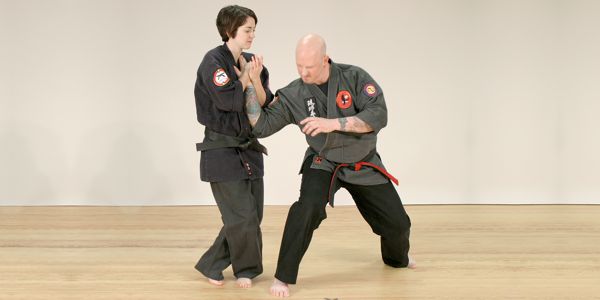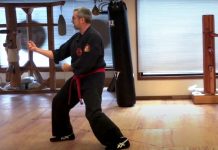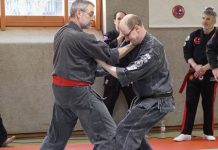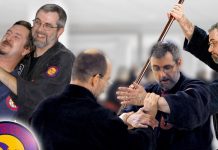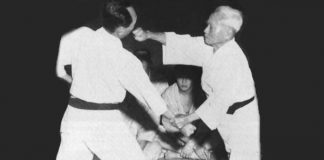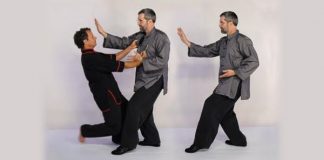One day George Dillman called me and said, “Weave been teaching women incorrectly!” Most martial artists will only reluctantly admit when they are wrong; Dillman, on the other hand, was positively ecstatic about learning something new.
He explained his findings in a convincing manner, but I am the type of person who must try things for himself. I don’t simply believe what I’m told, even if it is George Dillman doing the telling. So I conducted a simple test: I had my teenage daughter stand close to me (so I could not see her feet) and strike me lightly on the S-5 point. She struck my left S-5 with her right hand in four different ways: palm strike with her right heel down, palm strike with her right heel raised, fist strike with her right heel down and fist strike with her right heel raised. I did not tell her which techniques I expected to be more effective, nor did I designate what order she was to perform them in. She tapped me more than a dozen times. None of the blows was hard. Some of them produced nothing more than blunt impact, while others produced the buckling of the knees characteristic of a pressure-point strike.
When we were done, she told me her conclusions: Her palm strikes were more effective with her heel raised, while her fist strikes were more effective with her heel down—just as Dillman had predicted. It was hardly a placebo controlled, double-blind scientific study, but for me it seemed a reasonable demonstration of the difference between the male and female methods.—C.T.
And yet that statement is full of political implications. In recent decades, there has been a push to emphasize the equality of men and women and to break down the barriers that have kept women from fully participating in traditionally male-dominated areas of life and employment. But to say that men and women are equal is to make a statement of value. Men and women deserve equal protection under the law and equal access to the same opportunities for education, employment and self-expression. But men and women are not equal in the sense of “identical.”
When a woman walks into a martial arts school, she is entering a male world that uses male learning models, training methods and attitudes to study an art developed by males, for males. To the extent that everyone shares a common humanity, some of that curriculum should work for men and women equally. But to the extent that men and women are different, some of that curriculum should be expected to be ineffective, frustrating and perhaps even harmful for women.
One example is the prevalence of punching in the traditional arts. An observation of the spontaneous fighting styles of women and men shows that while men almost instinctively ball up their hands and hit with their fists, women tend to strike out with their palms. Slapping and clawing techniques are a common method for women. There is no doubt that this is an enormously effective approach; the existence of fu jow pai (tigerclaw style) and ying jow pai (eagle-claw style), and the widespread practice of ironpalm slapping methods in many traditions speak to the practicality of it. Yet women are typically instructed to punch rather than use an open-hand technique that would complement their natural inclinations.
Another problem with the usual approach to martial arts training is its emphasis on physical prowess. Because males have been romanced by images of fearsome masters smashing through stacks of concrete and ice, they have made the development of power a key part of training. As a result, they tend to value the cultivation of strength and toe-to-toe fighting as the ultimate arbiter of stylistic value—as demonstrated by the prevalence of no-holdsbarred competitions. It is interesting to note that highly nuanced martial arts, such as tai chi chuan, attract a significantly larger number of female adherents than do their less subtle hard-style counterparts. This alone should serve as an indicator that women seek an approach that does not rely on brute strength. The simple and obvious reason is this: In a self-defense encounter, a woman is almost always facing a physically stronger male aggressor.
Get the Point One of the most significant gifts to the martial arts community in recent years has been the reintroduction of pressure-point methods. Pressure points are the key to unlocking the meaning and value of traditional techniques and kata, and t h e y do not require strength to activate. They are also easy to attack because an assailant unwittingly exposes his own points when he reaches out for his intended victim.
Pressure point fighting, called kyusho jitsu, is an art that teaches the skills a person needs to defend himself or herself in a manner that relies not on physical prowess, but on the application of simple but effective combat principles.
It is well-suited for people who have reached or passed their physical prime and for those who are consistently faced with fighting physically stronger assailants.
Therefore, it would seem obvious that the most effective methods of self-defense available to women are those that are based on pressure-point fighting.
The use of pressure points has made all the difference in the world,” says eighth-degree Ryukyu kempo black belt Kim Dillman .
“This has led to the development of techniques that you can really use on the streets. It’s the great equalizer.
To share this equalizer, Dillman has begun conducting seminars on self-defense for women, as well as seminars for male instructors who teach women’s self-defense. This is important because even in pressure point fighting there are differences between the art as practiced by men and the art as practiced by women.
Jaw Strike One of the most common martial arts techniques is a diagonally upward strike aimed at a point called S-5 (daying). The point is found at the base of the masseter muscle (the muscle that bulges when you clench your teeth), at a palpable notch along the line of the jaw where a branch of the facial nerve curves around the bone.
The typical method involves using your right palm to strike S-5 on the opponent’s left side. The result of a light to moderate blow is a shocking sensation that causes the knees to buckle.
Many people describe the feeling as an electric shock; others report seeing a flash of light. However, when striking with the right hand to S-5 on the right side of the opponent’s face, the same electric shock is not felt unless the technique is performed with a fist. The common explanation for this is the interplay of polarities (yin and yang) between right and left, fist and palm.
From the surprising observation that a palm strike works better when hitting one side and a fist works better when using the same hand to strike the other side, a second revelation arises: Stance matters. For most people, the stances used in the martial arts are there primarily because they look cool. Some people do make use of stances in sparring, finding that a backweighted stance favors lead-leg kicking strategies, while a horse stance is a good position from which to spring forward with lunging backfist strikes. However, in these examples, the stance functions only as a base from which a maneuver is launched. But in kata, stance is integral to the execution of the technique.
And it is in pressure point fighting, in particular, that the importance of stance is evident. As it turns out, when the right fist is used to strike S-5 on the left side of the opponent’s jaw, it will produce the same feeling of electricity as a right palm strike if the fist strike is performed in a right cat stance.
The theory to explain this observation —and it is important to understand that the observation came first—is that raising the right heel alters the connection of the body to the ground. Ki (internal energy) is believed to pass through the feet into the ground and from the ground back into the body through the feet. In this way, the body is “grounded” to the earth. When the heel is lifted, the connection is broken, and energy that should have entered the ground through the sole of the foot is interrupted, resulting in a “ki backwash” in the body which briefly changes the effective polarity of the striking fist so it becomes similar to the polarity of a palm. This information is significant in and of itself. It represents a concrete, pragmatic application of a fundamental belief that lies at the root of all forms of energetic exercise and internal martial arts, namely that posture directly affects the flow of internal energy. But what is even more surprising and suggestive is that all these rules function in reverse for women.
The Female Way The methods of striking S-5 are so fundamental to pressure-point fighting that they are among the first taught.
Over the years, it was observed that women were not very successful at performing these techniques. The conclusion (of men) was that the women had been socialized not to hurt others and therefore withheld their full intent when striking.
In retrospect, I recognize that this was a rather sexist interpretation to make—and I am speaking only for myself —especially in light of these facts: • I have often made the point that most of the injuries I have suffered occurred when I served as uke (mock attacker) for a woman.
• Throughout my 30-plus years in the martial arts, some of the toughest people I have known have been women.
• Women have routinely demonstrated excellent skills in other aspects of kyusho jitsu.
• It is well known among members of Dillman Karate International that Kim Dillman was the first to perfect a pressure-point knockout, and that her husband, George Dillman, was her first victim.
The reason women had difficulty performing the standard S-5 strike was they were using a “male method,” when the interplay of polarities between women and men requires a reversal of that approach.
The “female method” of performing the S-5 strike is to use a right cat stance when executing a right palm strike to the left side of the opponent’s head, and stand flat-footed when using a fist.
Then, when crossing to strike the right side of the opponent’s jaw, the right palm strike is performed flat-footed, and the strike with the right fist is done in a right cat stance. (The male method is to use a cat stance when performing a right fist strike to the left side of the opponent’s head, and stand flat-footed when using a palm. Then, when crossing to strike the right side of the opponent’s jaw, the male method is a right fist strike performed flat-footed, and a right palm strike done from a right cat stance.) It should be noted that there is not truly a male and female method for striking S-5. In fact, what we are discussing is the method used in crossgender combat—“male” vs. “female.” In other words, a man using pressure points to fight a woman would actually use the female method. But since it is men who commit more than 90 percent of all violent attacks, the terms “male” and “female” are chosen on the reasonable assumption that the assailant will be a man, regardless of whether the target is male or female.
Statistically Speaking One of the criticisms that can be made here is that advanced practitioners are “slicing the ham too thin.” In other words, they are complicating things by insisting on minute technical aspects that produce benefits so slight as to be negligible in any other than ideal circumstances. So a fair question to ask is, Does the difference between foot up and foot down, and palm and fist really make a significant difference if S-5 is struck at the correct angle in the correct direction? The answer is yes. It makes a difference, and sometimes a significant one. But how important the gender-correct method is will vary somewhat from individual to individual.
Women will naturally fall into one of five categories in this regard, following a standard distribution (bell) curve.
The majority of women (roughly 85 percent) should find that the male/female distinctions described above apply to them personally. For these women, the male method may work somewhat, but the female method will have a clear advantage. A small percentage of women (roughly 5 percent) will find that the male method barely works while the female method is extremely successful. And for a still smaller group (about 2 percent), only the female method will work. On the other end of the spectrum, a similar group (roughly 5 percent) will find that the male and female methods seem to work equally well. And a smaller portion of women (about 2 percent) will find that the female method doesn’t work at all, while the male method works quite well. (Because the same spread occurs across the population of men in reference to the male method, all pressure-point practitioners should perform a simple test [see sidebar] to determine which statistical group they fall into.) Kim Dillman has conservatively estimated that a woman’s strike to S-5 will be, on average, 25 percent more effective if the female method is used. In combat, 25 percent is a huge amount. “Understanding this polarity difference between women and men has made an 80-percent art 100 percent effective,” she says.
Extrapolation Not Required With the recognition that differences between men and women need to be incorporated into martial arts training, a new question arises: Are all aspects of the arts different for each sex? The answer is no. For example, the gender difference is important in the delivery of strikes with the fist and palm because these hand formations have strong characteristics of yin and yang. But techniques such as the ridgehand and knifehand impact with areas of the hand that lie on the border between yin and yang. As a result, strikes delivered with these surfaces work identically for men and women.
However, there are some aspects of pressure point fighting that are purely male or female, and not affected by the gender of the attacker.
During traditional meditation, women have long been told to place their left hand in their right palm, while men are told to place their right hand in their left palm. At the beginning of many traditional kata, the right fist is placed in the left palm, but this is a strictly male method. Following the example from meditation, women need to place their left fist in their right palm. This is critical in bunkai (applications of kata movements and postures) that rely heavily on the proper flow of ki.
This should also serve as a warning to women engaged in chi kung classes: If they are told exactly the same thing as male students as to the direction of energy circulation and hand placement, the training may be harmful to them.
Research is on-going to identify further examples of gender specificity in martial arts techniques. In particular, women who are part of Dillman Karate International have been given a mandate to experiment and report on their discoveries with the hope that eventually all significant information can be incorporated into a comprehensive approach for women. This information can have a significant impact on how the martial arts are taught. “We will find,” Dillman concludes, “that there will be some attitude adjustments happening with those men out there who insist on domination and control.”

